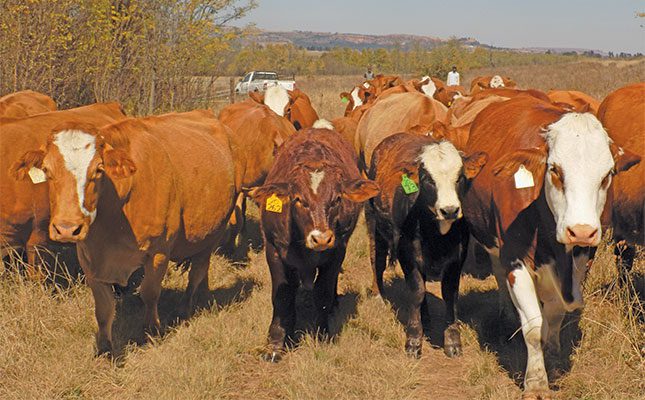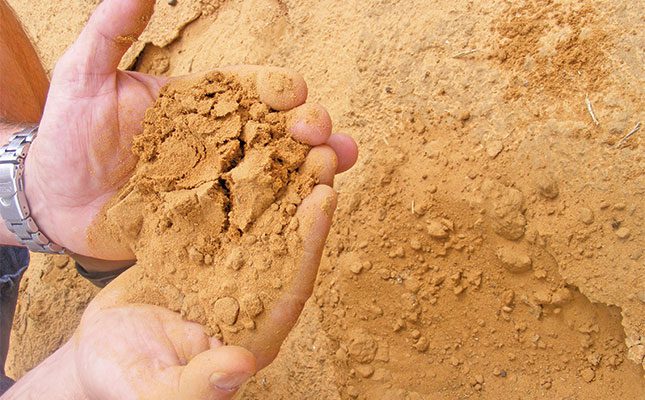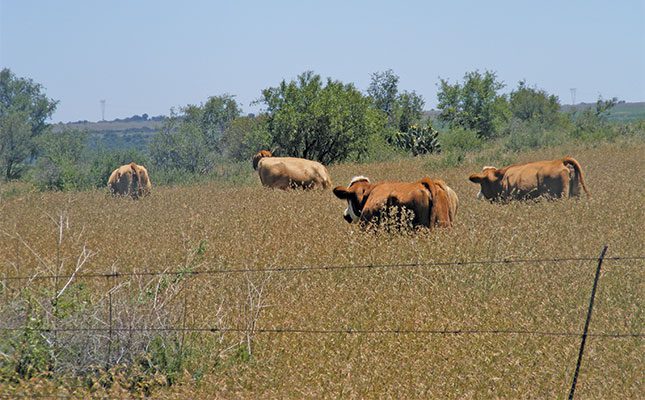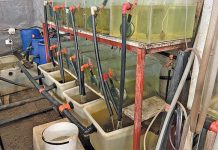
Photo: Annelie Coleman
Healthy and biologically active soil affords cattle producers indirect support through a number of ecological services like higher plant mineral concentrations, soil carbon sequestration, improved water storage capacity, and the prevention of soil erosion.
Livestock from a healthier environment will most likely benefit from this in a positive way.
“Many other factors, such as management practices, infectious and parasitic diseases, nutrition and water quality, and geology also influence the health and productivity of cattle.
“However, the implementation of healthy soil practices in synchronisation with nature
is bound to play an important contributing role to more profitable cattle farming,” says
Dr Jan Myburgh, senior lecturer in pharmacology and toxicology in the Faculty of Veterinary Science at the University of Pretoria.
According to him, crop farmers generally understand the value of well-balanced soil and many have started to apply regenerative farming principles to improve and restore soil biology, especially over the past decade or two.
Crop production is measurable, and the financial income per hectare can be calculated to the last cent. Crop farmers are able to determine profits (hopefully higher ones), and can make comparisons between conventional methods, especially where the different methods are weighed against each other in the same district or on the same farm.
The time has come for cattle breeders to take the same stance in terms of the income generated on well-balanced soils compared with the income realised on substandard and neglected soils.
Five principles
Myburgh explains that farmers intent on improving the well-being of their soils need to work according to the five principles that have been proven as essential for dynamic soil biology.
The five principles are the minimisation of soil disturbance, the maximisation of plant diversity, keeping the soil covered, maintaining living roots, and integrating livestock.
“Although the use of livestock is one of the five principles recognised as an important option for diversification in crop farming, the other four principles can also be applied to improve natural veld, plants and the health of the soil underneath,” says Myburgh.
Soil properties are divided into physical, chemical, and biological classes.
“The physical and chemical properties of soil are relatively easy to evaluate and test in a laboratory. It is the biological properties of the soil that remain the least understood yet have the greatest potential to improve soil function and to increase plant productivity.
“It is therefore obvious that if the soil is biologically ‘unhealthy’ or not performing all of the functions it is supposed to, then the rest of the environment, including the plants, water and animals will be negatively affected,” he continues.
Soil biology and function
As the saying goes, livestock farmers are, in truth, grass farmers before they are livestock farmers. But, according to Myburgh, they are first and foremost soil farmers.
In order to supply enough grazing, the soil must always be considered. Soil health boils down to the capacity of the soil to function optimally. This depends on the conservation and maintenance of five soil functions, namely the preservation of biodiversity and productivity, water and solute flow, filtering and buffering, nutrient and water cycling, and structural support.
“Healthy soils are dynamic and alive and allow plants to flourish,” says Myburgh.
Healthy soil must be alive and should look, smell, feel, and function as such. Observation of healthy soil should reveal a dark colour from organic matter, soil-associated micro-organisms, invertebrates and vertebrates.

Biologically sound soils should have a distant ‘healthy’ odour that’s slightly sweet and should perform the basic roles of water and nutrient cycling and physical support.
Healthy soil is home to an astounding quantity of the world’s biodiversity. Soil biology is the study of soil microbe ecology and its activities, and all the other organisms that spend a significant portion of their life cycle within the soil, or at the soil-litter interface.
These organisms include micro-organisms and invertebrates, as well as some soil-loving vertebrates.
“Soil biology plays an essential role in determining a host of soil characteristics. The decomposition of organic matter by soil organisms has an immense influence on soil fertility, plant growth, soil structure, and carbon storage. The direct and indirect links between soil organisms and soil functions are complex. The interconnectedness and complexity of this soil food web means any appraisal of soil function must seriously consider the living communities that exist within the soil,” explains Myburgh.
Effects of healthy soil
For a cattle producer, it is important to know that healthy soils improve plant health, quality and quantity; support biodiversity above ground; increase production per hectare; and support water infiltration and retention. Healthy soils also reduce water run-off, sequester carbon, and control pioneer and poisonous plants.
Soil organisms break down organic matter, making nutrients available for uptake by plants and other organisms. Without the biodegrading activities of soil organisms, organic materials would accumulate and litter the soil surface without becoming ‘food’ for plants.
Nutrients stored in the bodies of soil organisms prevent nutrient loss through leaching. Soil organisms also play essential roles in the different intra-soil and other soil-associated cycles.

“Microbial exudates maintain soil structure, while larger invertebrates, such as earthworms, termites and dung beetles, play a vital part in soil bioturbation, which is the disturbance or reworking of soil by animals due to burrowing, ingestion and defecation.
Micro-organisms have a range of direct effects on plants through, for instance, hormone signalling and protection against pathogens. Plants communicate with the micro-organisms through metabolites exuded by the roots. Friendly micro-organisms can help plants grow by helping the plants to obtain nutrients such as phosphorus, nitrogen and a variety of minerals.
“However, the relatively recent discovery of glomalin in 1995 shows that we lack the knowledge to correctly answer some of the most basic questions in soil biology, and more work still needs to be done to increase the biology of soils,” explains Myburgh.
Glomalin is a proteinaceous substance in soil that binds soil particles together and acts as a bio-glue to promote the formation of large aggregates and increase the stability of the soil’s structure. It allows for better penetration of water and air, reducing the formation of a surface water layer and soil erosion. It is produced by soil fungi.
“For any livestock farmer interested in optimal veld management, the most important question should be if there is any benefit to livestock if they consume grass growing in biologically healthy soil,” he says.
The direct benefits that biologically sound soil offer livestock producers soil include higher biomass production of grazing per hectare and therefore also a higher production of kilograms of beef per hectare. It also increases macro- and trace mineral bio-availability, which adds to livestock health and productivity.
Gastrointestinal and soil micro-organism functioning
Gastrointestinal functioning in livestock ruminal function and the intra-ruminal micro-organism activity are comparable to the functions and activities of soil micro-organisms.
Whenever the micro-organisms inside the rumen are dead or not functioning optimally, the ruminant will become unhealthy. Similarly, if soil micro-organisms (soil biology) are absent or not active anymore, then the soil can also be considered ‘sick’ or dead.

The monitoring of soil and ruminant health is a very important ongoing activity. In most well-managed livestock herds, the animal health focus is most often well taken care of.
However, the monitoring of soil, plant and animal health together is often not given any attention.
A more holistic approach to farm monitoring and livestock management is clearly more meaningful and preferable in a modern approach to farming.
Email Dr Jan Myburgh at [email protected].











